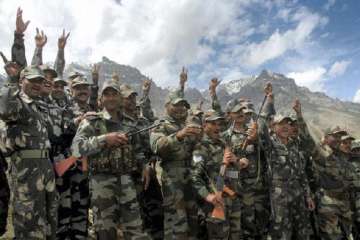Kargil Vijay Diwas: What had happened during the 1999 Indo-Pakistan war. Watch full documentary
On this day in 1999, the Kargil War between India and Pakistan had come to an end after the Indian soldiers had recaptured the mountain heights successfully, which were taken over by the Pakistani intruders. It is believed that Pakistan had started planning the attack a year in advance. More so, Nawaz Sharif had claimed that he had no knowledge of the attack till he got a call from Atal Bihari Vajpayee. Read on to know of what had happened in the Kargil War.

India celebrates the 20th anniversary of Kargil Vijay Diwas today. Back in 1999, the Kargil war, which is also known as the Kargil conflict, formally came to an end as the Indian soldiers had successfully recaptured the mountain heights that were seized by intruders from Pakistan. Kargil war went on from May 3 to July 26, 1999 after Pakistani troops were seen at the Kargil ridges.
The Kargil War was prompted by the Pakistan Army intruding into India across the Line of Control and capturing strategic mountain peaks. The intrusion was first detected in May 1999, but at that time it was assumed that the intruders were militants or terrorists and not regular Pakistan Army troops.
Pakistan had started planning the attack in 1998 itself. According to some beliefs, it is said that the proposal for such an attack was laid by previous Pakistan Army chiefs.
In fact, then Pakistani Prime Minister Nawaz Sharif had claimed that he had no knowledge of such an attack till he got a call from his Indian counterpart Atal Bihari Vajpayee.
Over the next few weeks, as Indian soldiers fought valiant battles to reclaim the heights of Kargil, it became apparent that it was actually the Pakistan Army that had intruded across the Line of Control.
A military and diplomatic blitz was launched by India in response, which pushed the Pakistani intruders off the captured heights and isolating Islamabad on a global level.
With the killing of over 500 Indian soldiers, India recaptured all the peaks by July 26, 1999, bringing the Kargil conflict to an end.
Kargil War: Full Documentary on India-Pakistan War 1999
What was Operation Badr
Operation Badr was a code name for the infiltration of Pakistani Armed Forces into the Indian territory in 1999. The code name aimed to cut off links between Kashmir and Ladakh, which forced India to negotiate a settlement of the Kashmir dispute. Initially, Pakistan pinned the blame of the attack on Kashmiri insurgents but the documentary evidence from the casualties proved Pakistan Army's direct involvement in the attack.
Former Prime Minister Atal Bihari Vajpayee and Nawaz Sharif had signed the Lahore Declaration in February 1999, when the armed conflict between India and Pakistan in Kargil and elsewhere along the Line of Control (LoC) was underway.
A conference between the two leaders actually aimed at de-escalating the Kashmir tensions. However, the issue further flared up after the Kargil war.
The three phases of Kargil war
The Kargil war had three phases - infiltration by Pakistan so as to occupy strategic locations to bring NH1 within its control, identifying and responding to Pakistani infiltration and battles between Indian and Pakistani forces.
What happened in 1999 Kargil war
The area, which has high mountains, harsh winds and temperatures that drop to as low as minus 60 degrees Celcius in winter, led to an agreement between India and Pakistan, which underlined that both the armies will keep from occupying posts from September 15 to April 15 each year. The agreement was, however, breached by Pakistan, in an attempt to take over Kashmir.
Over a period of several months, Pakistan infiltrated into the Mushkoh Valley, the Marpo La ridgeline in Dras, in Kaksar near Kargil, in Batalik sector, in Chorbatla sector and in Siachen's Turtok sector. The infiltration was later exposed after an Indian patrol team acted on a tip-off by a local shepherd in the Batalik sector.
Ascertaining the extent of the infiltration, India responded with Operation Vijay and mobilised 200,000 troops. Operation Safed Sagar, which became a part of the Army on May 26 was launched by the Indian Air Force.
With Army and IAF already in operation, the Indian Navy strategically mounted pressure on Pakistan through Operation Talwar, which included aggressive patrolling off the Pakistani coasts.
The National Highway 1 (NH1), which was the lifeline of India for logistics and supply, was under Pakistani watch from over 130 of their occupied observation posts.
Along with being equipped with small arms and grenade launchers, the infiltrators were also armed with mortars, artillery and anti-aircraft guns.
India, thus, prioritised regaining control of the hills that overlooked the National Highway 1. Overlooking NH 1 before it turned to pushing the intruders back across the LoC, India regained control of these hills over the next two months.
Not anticipating such a fierce retaliation from India, Pakistan moved to America to seek help in de-escalating the border tensions. The then US President Bill Clinton, however, refused to intervene until Pakistan withdrew its forces from the Indian side of the LoC.
Meanwhile, Pakistan also had to bow down to international pressure along with the sustained retaliation from Indian forces and move back to its territory.
In close coordination with the Indian Air Force, the Indian Army launched its final attacks in July 1999, which eliminated the Pakistani forces from the area. The victory of the Indian Army, since then, is celebrated as Kargil Vijay Diwas on July 26 every year.
Also Read | President Kovind to join Kargil victory celebrations in Drass
Video: India celebrates 20th Anniversary of Kargil Vijay Diwas